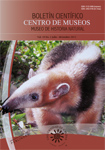Autores/as
Resumen
El entorno natural es y ha sido modificado acorde a las necesidades humanas, ya sea para la urbanización o la expansión de las áreas de cultivo. El cambio en la cobertura de las áreas trae consigo un cambio en la diversidad asociada. Los insectos son uno de los grupos mejor estudiados en ecosistemas agrícolas, sin embargo dicho conocimiento se limita generalmente a las especies plaga y sus reguladores biológicos. Las mariposas han sido usadas como un grupo indicador ya que permiten evaluar el impacto de las prácticas de manejo y modificación del hábitat. Esto, motivó el estudió de la diversidad de mariposas diurnas asociadas a un agroecosistema citrícola en el cañón del río Cauca, Colombia. El muestreo arrojó un registro de 76 especies representadas mayoritariamente por la familia Nymphalidae. Este trabajo contribuye así al conocimiento de la lepidopterofauna colombiana y a incrementar los datos de distribución de mariposas diurnas en América.
Palabras clave
Citas
BECCALONI, G. & GASTON, K.J., 1995.- Predicting the species richness of neotropical forest butterflies: Ithomiinae (Lepidoptera: Nymphalidae) as indicators. Biological Conservation, 71 (1): 77-86.
BROWN, J.K.S., 1997.- Diversity, disturbance, and sustainable use of Neotropical forests: insects as indicators for conservation monitoring. J. Insect Conserv., 1: 25-42.
CANADELL, J.G., CIAIS, P., DHAKAL, S., LE QUÉRÉ, C., PATWARDHAN, A. & RAUPACH, M.R., 2009.- The Global Carbon Cycle - 2. UNESCO-SCOPE-UNEP, Paris.
CASSON, A., 2003.- Oil Palm, Soybeans & Critical Habitat Loss. WWF Forest Conversion Initiative, Switzerland.
CONSERVATION INTERNATIONAL FOUNDATION, 2007.- Biodiversity Hotspots. Recuperado de http://www.biodiversityhotspots.org (última visita 23 enero de 2012).
FAO (Organización de las Naciones Unidas para la Agricultura y la Alimentación), 2009.- Situación de los bosques del mundo. Subdivisión de Políticas y Apoyo en Materia de Publicación Electrónica, División de Comunicación. FAO, Roma - Italia.
GALLINA, S., MANDUJANO, S. & GONZÁLEZ-ROMERO, A., 1996.- Conservation of mammalian biodiversity in coffee plantations of Central Veracruz, Mexico. Agroforestry Systems, 33 (1): 13-27.
GREENBERG, R., BICHIER, P. & STERLING, J., 1997.- Bird Populations in rustic and planted shade coffee plantations of Eastern Chiapas, Mexico. Biotrópica, 29 (4): 501-514.
HOLDRIDGE, L.R., 1967.- Life Zone Ecology. Tropical Science Center, San José.
LAMBIN, E.F., GEIST, H.J. & LEPERS, E., 2003.- Dynamics of land-use and land-cover change in tropical regions. Ann. Rev. Environ. Resour., 28: 205-241.
MUNYULI, T., 2011.- Assessment of indicator species of butterfly assemblages in coffee-banana farming system in central Uganda. Afr. J. Ecol., 50: 77-89.
PERFECTO, I., MAS, A., DIETSCH, T. & VANDERMEER, J., 2003.- Conservation of biodiversity in coffee agroecosystems: a tri-taxa comparison in southern Mexico. Biodiversity and Conservation, 12: 1239-1252.
PERFECTO, I. & VANDERMEER, J., 1994.- Understanding biodiversity loss in agroecosystems: Reduction of ant diversity resulting from transformation of the coffee ecosystem in Costa Rica. Trends in Agricultural Sciences, 2: 7-13.
PERFECTO, I., VANDERMEER, J., HANSON, P. & CARTIÂN, V., 1997.- Arthropod biodiversity loss and the transformation of a tropical agro-ecosystem. Biodiversity and Conservation, 6: 935-945.
PIN, L., 2008.- Can oil palm plantations be made more hospitable for forest butterflies and birds? Journal of Applied Ecology, 45: 1002-1009.
PINEDA, E., MORENO, C., ESCOBAR, F. & HALFFTER, G., 2005.- Frog, Bat, and Dung Beetle Diversity in the Cloud Forest and Coffee Agroecosystems of Veracruz, Mexico. Conservation Biology, 19 (2): 400-410.
PINHEIRO, C.E., MEDRI, Í.M. & SALCEDO, A.K., 2008.- Why do the ithomiines (Lepidoptera, Nymphalidae) aggregate? Notes on a butterfly pocket in central Brasil. Rev. Bras. Entomol., 52 (4): 610-614.
RAMANKUTTY, N. & FOLEY, J.A., 1999.- Estimating historical changes in global land cover: croplands from 1700 to 1992. Glob. Biogeochem. Cycles., 13 (4): 997-1027.
RÍOS-MÁLAVER, C., 2007.- Riqueza de especies de mariposas (Hesperioidea & Papilionoidea) de la quebrada "El Águila" Cordillera Central (Manizales, Colombia). Bol. Cient. Mus. Hist. Nat. U. de Caldas, 11: 272-291.
SEABROOK, L., MCALPINE, C. & FENSHAMB, R., 2006.- Cattle, crops and clearing: Regional drivers of landscape change in the Brigalow Belt, Queensland, Australia, 1840-2004. Landscape and Urban Planning, 28: 373-385.
VITOUSEK, P.M., MOONEY, H.A., LUBCHENCO, J. & MELILLO, J.M., 1997.- Human domination of Earth's ecosystems. Science, 277 (5325): 494-499.
WARREN, A.D., DAVIS, K.J., STANGELAND, E.M., PELHAM, J.P. & GRISHIN, N.V., 2012.- Illustrated Lists of American Butterflies. Recuperado de http://www.butterfliesofamerica.com (última visita septiembre de 2012).

 PDF
PDF
 FLIP
FLIP























